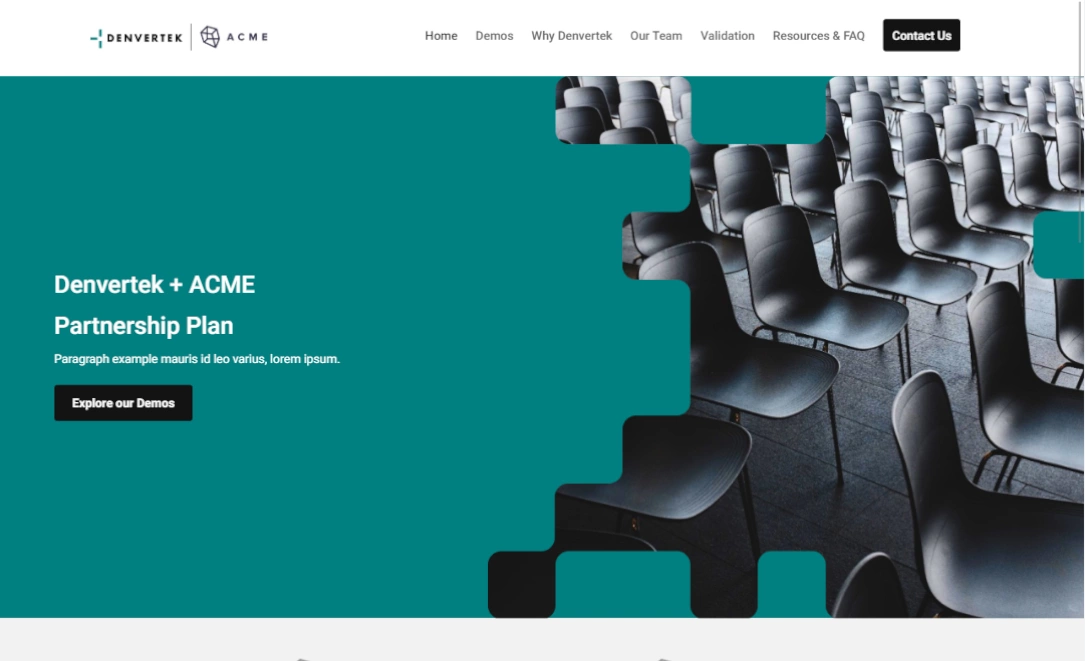Making the right first impression on a client is not as easy as it seems, especially when it comes to creating the perfect sales proposal. It’s important to come across as a subject expert, a dependable partner, and a professional who values the importance of presentation.
It’s a lot of pressure! Luckily, the right tools can help you and your team roll out a sales proposal that will not only impress your clients but will help you close on your sales too. A digital sales proposal is the best way to keep your deliverables up-to-date, accessible, and polished.
The benefits of a microsite sales proposal
Author of “The Collaborative Sale” Timothy Sullivan cites follow-up communication and useful summaries as important qualities that leave prospects impressed. He notes that this necessary part of the proposal process establishes credibility and makes it easier for prospective buyers to identify how potential buyers can offer them fine-tuned solutions.
A trend Sullivan writes about includes a growing transition to “[sharing] these communications in a shared online collaboration space, along with any relevant supporting content.” The benefits of these changes are two-fold. One, it makes it easier for buyers to share useful information within their organizations. Two, it gives sales teams more insight into what information their clients are engaging with.
All of your key information in one place
Getting your potential clients and partners all of the information they need is a critical part of building an effective sales proposal. Information is a core aspect of establishing credibility, an important factor in how clients decide on which products or services they will work with.
Sharing information, however, can sometimes feel like the most “salesy” part of establishing a relationship with a potential client. Print deliverables are often impersonal, and even if they have a ton of information on them, the collection of loose sheets, brochures, and binders probably feels a little bit like a hassle to revisit.
It makes it hard for your client to share the information across their organization and the impersonal nature of the deliverables you share can make your approach feel “one-size-fits-all.”
Customizing print deliverables is easier said than done and can be a serious strain on time and money. Luckily, there is a better, sleeker solution than toying around with customized documents!
Microsites make it easy to house all of your information in one place that can be easily accessed and searched through.
Headings and subpages make it easy for clients to know where to look for the information they need. It allows sales teams to house extra information in their proposals without added clutter, a plus for everyone involved. Plus, through design, you have the added opportunity of emphasizing the key features or ideas you want your clients to focus on.
Microsites create sleek proposals that can be duplicated and customized for each of your clients, including adding custom branding and logos. This adds a personal touch to your proposal, even if it is just a standard template you use.
An interactive, accessible proposal for clients
Microsites make it easy to distinguish yourself from the competition, who may opt for the more traditional slide deck or PDF. You can easily include high-quality, eye-catching visual elements like videos and image galleries in your proposal. It’s the perfect way to create a polished look that breaks up information and appeals to your target audience’s values.
It doesn’t stop there, either. Try elevating information sharing with interactive graphs and charts. It’s an easy and effective way to get pointed information across to your clients without bogging down your proposal with text.
Including extra flair in your microsite is the perfect way to add a personal touch to your proposal and grab the client’s attention. Need more? You can even include polls and social media feeds to boost client engagement.
A data-driven approach to proposals
The greatest advantage of using a digital sales proposal is its data, especially a highly trackable digital solution like a microsite.
It makes it possible for you to gain visibility into how and when your proposal is being used by prospective clients, taking the guesswork out of follow-up and allowing your team to fine-tune the next steps of their strategy.
Follow-up is an essential part of moving your proposal towards closing; however, it can be challenging to know how to approach follow-up.
Advanced analytics allow you to time your follow-up so it corresponds with when your clients last opened your proposal. You can easily address the points your clients engaged with the most or least in your follow-up communication by looking at a granular level breakdown of your microsites traffic and engagement.
It also tells you which attachments, media content, and landing pages were most visited. You’ll also have access to page views, average site visit length, and information about link sharing.
How to build a simple sales proposal as a microsite
Determine the problem and your solution
Before you start putting together your sales proposal, it’s important to understand the problems your client has. The more in-depth your understanding of the problem is, the better. It will allow you to fine-tune your approach and demonstrate that you have a developed understanding of the unique problems your client is hoping to address.
The more focused your solution and your proposal are, the more likely your client will see value in what you have to offer. It establishes that you are an expert in the subject area you are targeting and communicates value to your client, qualities that set “winning” sales teams apart from “losing” ones.
Demonstrate your awareness of the problems your client is facing on your proposal’s main page; it will grab their attention and compel them to explore the remainder of the proposal. Make use of CTAs and hyperlinks whenever possible, as it will get your clients to the information they are looking for quickly.
Figure out what content to include
Including relevant and engaging content in your proposal is how your team showcases their expertise and available resources.
Put together a robust collection of documents and necessary information your client will be interested in. Your list should include pieces that get down to the brass tacks of the services you are offering and what sells your company on a holistic level. Think testimonials, success rates, and qualifications.
Because this is all digital, there’s more flexibility in how much you can offer your clients, especially if you leverage the right design strategies. Here is a working list of some of the information your clients might hope to see:
- Client testimonials
- Case studies
- Coordinating team and project manager contact information or qualifications
- Special features in media like podcast features, news segments, or editorials
- Pertinent presentations or one-sheets (housed in a linked document library)
Check out this sample of a digital sales proposal for design inspiration!
Define your success criteria
Sharing a plan for action with your clients is one-half of the problem-solving process. The part they’re likely most interested in as they prospect solutions is what success will look like.
Create a clear outline of how your performance can be measured and seen over time. It may look like milestones, KPIs, or performance rates. Whatever it may be, determine milestones that are reasonable and actionable so that you can create realistic expectations for your client that they can anticipate from your work.
Choose a template and add content
Now that the bones of your proposal are set in place, it’s time for you to create a clean, put-together proposal that your client can easily navigate.
Zoomforth makes this a fairly painless process. All you have to do is pick a template and customize it for your business’s unique brand and personality. It’s as easy as dragging and dropping the site elements you want to see in an intuitive design tool.
Opt for a template with sub-pages that are easy to see at the top of the page and be sure to include tools like a search bar to make finding information especially easy.
Your preview will update as you edit so that you can see what changes look like without leaving the design hub. It makes customizing premade templates simple so that your microsites are beautifully designed every time.
Once you’ve created a proposal microsite you like, you can duplicate and change content for each of your clients. It makes each proposal unique without the added work of overhauling and starting from scratch.
Create a custom URL to send to clients
Once your microsite is fully constructed and ready to go, all that’s left is to create a shareable link!
Now, ease of access shouldn’t mean a lack of security. Zoomforth makes it easy to create content that is accessible to only the right people. SAML and multifactor authentication make it easy to ensure that your proposal only goes where it needs to. It keeps your proposal and client information secure, offering the peace of mind that emailed attachments can’t.
Your microsite is automatically formatted to display across mobile devices. This makes it easy for your clients to access your shared proposal anywhere, at any time.
For more information on creating microsite sales proposals, check out our whitepaper on the subject!
Building a microsite sales proposal is simple with Zoomforth
As you can see, a microsite is an awesome platform for demonstrating your value as a company to prospects. If you’re looking for a way to gain insight into client prospecting and create sales proposals that sell, it may be time for you to see what Zoomforth has to offer.
Zoomforth is a microsite builder that offers you free range in microsite creation on an intuitive, drag-and-drop platform. We’ll host your microsite in a secure cloud server, and you’ll have all the analytics you need to measure your sales proposal’s success.
Try a demo of the microsite service that leaders across industries trust for their enterprise-level communication needs.
Photo by John Schnobrich on Unsplash



